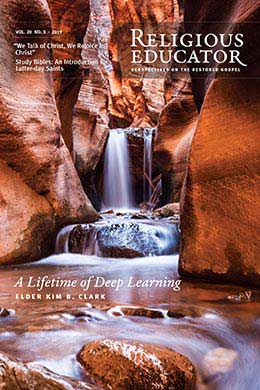CES Missionary Couples Serving around the World
Po Nien (Felipe) Chou and Petra Chou
Po Nien (Felipe) Chou and Petra Chou, "CES Missionary Couples Serving around the World," Religious Educator 20, no. 3 (2019): 155–75.
Po Nien (Felipe) Chou (choupn@churchofjesuschrist.org) was a religious educator for Seminaries and Institutes of Religion when this was published.
Petra Chou (chou_fmly@yahoo.com) was a teacher in the Chinese immersion program for the Alpine School District in Utah when this was written.
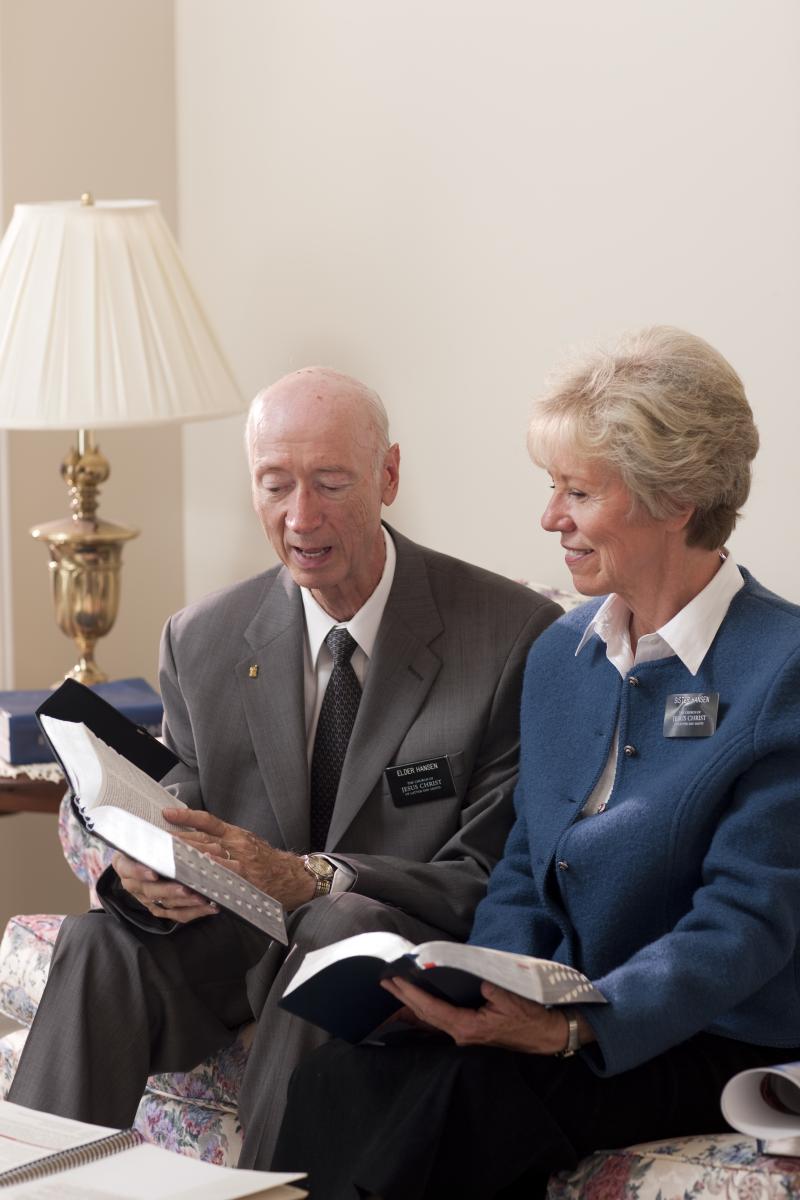 Senior missionaries are especially needed because they can serve in areas where younger missionaries can't.
Senior missionaries are especially needed because they can serve in areas where younger missionaries can't.
In 1992 the Church sent six missionary couples to Mongolia at the government’s invitation to teach and help improve the educational system in Mongolia.[1] These missionary couples were based in Ulaanbaatar, the capital city of Mongolia. They came from a range of educational experiences and backgrounds and were uniquely qualified to help with the development and planning of higher education in Mongolia.[2] Their experience and background included “a medical doctor responsible for postgraduate studies at a university medical center, a computer science professor, a business professor, a professor of curriculum development and administration, and an educational administrator.”[3] Although these couples came from a variety of teaching backgrounds, their professional and educational experiences would help them with both the secular and spiritual education they provided during their mission. Their service included teaching at universities while also helping to pave the way for the gospel to be preached among the people of Mongolia. The initial effort of these couples to assist with secular education in Mongolia would lead to the organization of branches (along with branch and Relief Society presidencies), the preaching of the gospel, the first baptisms, and the subsequent establishment of seminary and institute programs throughout Mongolia.
When another missionary couple from Utah received their mission call to serve in Asia, they had no idea they would be the first Church Educational System (CES) or Seminaries and Institutes (S&I) senior missionary couple to serve in Taiwan.[4] Although they did not speak the language, “they taught with the assistance of local translators, had a great love for the [seminary and institute] students, and were vital in supporting the growth of the S&I programs in central Taiwan until they completed their mission in 2002.”[5] Like other missionary couples serving around the world, these missionary couples in Mongolia and Taiwan were a blessing to those they served and helped to strengthen the youth and young adults of the Church around the world. This article examines the call, training, and experiences of CES senior missionary couples serving throughout the world.
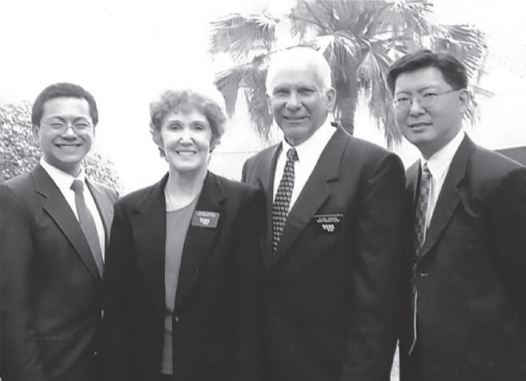 Elder & Sister Sipherd were the first CES missionaries to serve in Taiwan. From left to right: Po Nien (Felipe) Chou (CES coordinator), Sister and Elder Sipherd, Kam Tim Kwok (CES area director) in Taiwan in April 2001. Courtesy of Po Nien (Felipe) Chou and Petra Chou.
Elder & Sister Sipherd were the first CES missionaries to serve in Taiwan. From left to right: Po Nien (Felipe) Chou (CES coordinator), Sister and Elder Sipherd, Kam Tim Kwok (CES area director) in Taiwan in April 2001. Courtesy of Po Nien (Felipe) Chou and Petra Chou.
Processing Mission Calls at the Church Office Building
An Area Presidency or an S&I area director may initiate a request for a CES missionary couple. These requests for missionary couples are sent to the Church Office Building in Salt Lake City, Utah. A former area director who has worked with several missionary couples assigned to various countries in Asia said that they regularly needed additional missionary couples to assist in his area. He indicated that these missionary couples brought a wealth of Church experience to their calling and assignment.[6] In another continent, another past area director in the Africa Southeast area added that he could often use more missionary couples and that they were a blessing to the members in his area.[7]
When prospective senior missionary couples complete their application, they indicate their experiences and abilities, as well as their preferred type of mission. When their missionary application arrives at Church headquarters in Salt Lake City, senior missionary coordinators from various departments help with the initial review and recommendation for a couple’s potential assignment based on their background and experience. Former senior missionary coordinators explained their role in helping to process senior missionary applications.[8]
There are fourteen departments of the Church who have senior missionary coordinators. Once a senior missionary application is received, we (and senior missionary coordinators from other departments) review the application, tag it as necessary, and make recommendations. Each application may have three or four department recommendations, which are prioritized and then sent to a General Authority for review and assignment. For potential CES mission assignments, we look at those with strong educational backgrounds and who may work or connect well with the youth.[9]
Requests for senior missionaries from all over the world are grouped into four categories: top, high, medium, or low priority. As the senior missionary coordinators review missionary applications, they make recommendations based on these priorities. However, since there are more requests than senior couples available, only about half the requests are filled (for example, top- and high-priority requests).[10] The global operations manager for the Church-Service Missionary office explained in 2017 that “we receive requests daily from mission presidents and from all the Church departments and operations requesting more senior missionaries,” but only about 50 percent of the requests for full-time senior missionaries and Church-service missionaries are filled.[11]
Once the senior missionary coordinators from the various departments submit their recommendations and priorities, they wait for the mission calls and assignments to be made, which may take a week or two. A former senior missionary coordinator said, “We make recommendations and then leave it up to the Brethren.”[12]
Elder David A. Bednar, of the Quorum of the Twelve Apostles, described the difference between mission calls and their accompanying assignments:
Every year tens of thousands of young men and young women, and many senior couples, eagerly anticipate receiving a special letter from Salt Lake City. . . .
Each mission call and assignment, or a later reassignment, is the result of revelation through the Lord’s servants. A call to the work comes from God through the President of the Church. An assignment to one of the more than 400 missions presently operating around the world comes from God through a member of the Quorum of the Twelve Apostles, acting with the authorization of the Lord’s living prophet. The spiritual gifts of prophecy and revelation attend all mission calls and assignments.[13]
Elder Ronald A. Rasband, then serving in the Presidency of the Seventy, shared his experience of observing the process of assigning missionaries with President Henry B. Eyring.[14]
I joined Elder Eyring early one morning in a room where several large computer screens had been prepared for the session [to make missionary assignments]. There was also a staff member from the Missionary Department who had been assigned to assist us that day.
First, we knelt together in prayer. I remember Elder Eyring using very sincere words, asking the Lord to bless him to know “perfectly” where the missionaries should be assigned. . . .
As the process began, a picture of the missionary to be assigned would come up on one of the computer screens. . . .
Elder Eyring would then study the comments from the bishops and stake presidents, medical notes, and other issues relating to each missionary.
He then referred to another screen which displayed areas and missions across the world. Finally, as he was prompted by the Spirit, he would assign the missionary to his or her field of labor. . . .
At the end of the meeting Elder Eyring bore his witness to me of the love of the Savior, which He has for each missionary assigned to go out into the world and preach the restored gospel. He said that it is by the great love of the Savior that His servants know where these wonderful young men and women, senior missionaries, and senior couple missionaries are to serve. I had a further witness that morning that every missionary called in this Church, and assigned or reassigned to a particular mission, is called by revelation from the Lord God Almighty through one of these, His servants.[15]
After the mission call has been accepted, letters are sent to welcome those called and to notify their mission president and area director. These senior missionary couples are added to the missionary training center list and begin to receive information and materials in preparation for their call.[16]
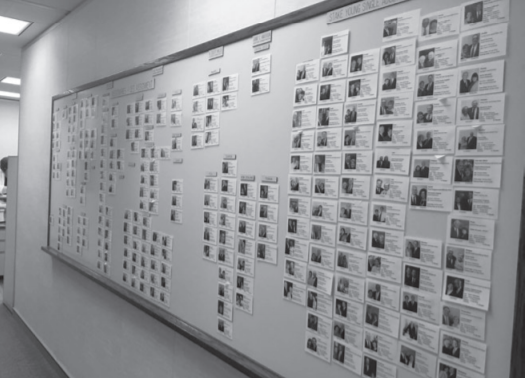 Missionary white board at the Church Office Building in Salt Lake City, Utah, in 2018. Courtesy of Po Nien (Felipe) Chou.
Missionary white board at the Church Office Building in Salt Lake City, Utah, in 2018. Courtesy of Po Nien (Felipe) Chou.
A picture and assignment of each new CES missionary couple are then added to a large whiteboard used to track these senior missionary couples around the world. A former senior missionary coordinator said, “We are responsible for all CES senior missionary couples going out to serve, and we do all we can to communicate with them and help ease any anxiety they may have in preparing for their missionary service.”[17]
Training at the Missionary Training Center
Senior missionary couples entering the Missionary Training Center (MTC) in Provo, Utah, come with diverse experiences and backgrounds. A survey conducted with senior missionary couples in the MTC in October 2011 by the S&I Office of Research found that 64 percent of senior missionaries going on a CES mission attended seminary as a youth and 36 percent taught early-morning seminary previously for an average of 1.2 years. Although most had heard of seminary and institute, only 26 percent were familiar with the CES section in the Church Handbook of Instructions.[18]
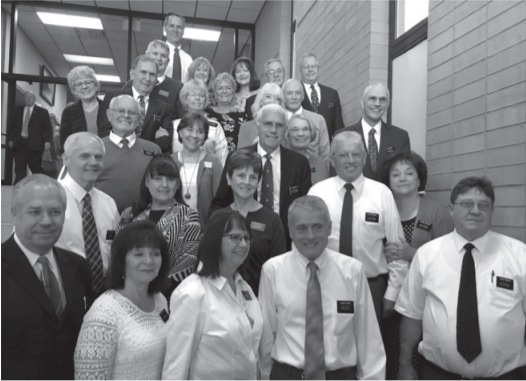
In addition, survey responses from senior missionary couples preparing to leave the MTC indicated that they had three main expectations with the training during their time at the MTC. First, couples anticipated learning seminary and institute organizational structure and core documents. One senior missionary couple leaving for Africa wondered, “What is CES?,” “How does CES work?,” and “Is there a set of CES manuals and handbooks?” Another missionary couple heading to Asia asked, “What is the structure of CES/
These senior missionary couples generally spend a week and a half at the MTC in Provo, Utah. Their first week is spent with trainers who review Preach My Gospel with them, followed by three days of training specific to their assignment. A team of seminary and institute teachers is sent from the Training Division to assist with this training. A former Training Division director explained that the training in Provo intends to assist with the following:
- Introduce both the Objective of Seminaries and Institutes of Religion and the Teaching and Learning Emphasis (renamed the Fundamentals of Gospel Teaching and Learning).
- Provide a broad overview of typical assignments and experiences, leaving details of the specific assignment to be covered once they reach their assigned area.
- Help senior missionaries learn how to use the S&I curriculum to prepare and teach effectively in a seminary or institute setting.
- Some administrative training, including accessing resources and materials online, working with priesthood leaders, and brief introduction to other administrative tasks.
- The senior missionary coordinators share thoughts and experiences.
- Others (for example, BYU–Pathway, Perpetual Education Fund, and so forth) may also provide training as needed.[20]
During a training in Provo, one trainer acknowledged the sacrifice that many of the senior missionary couples were making, while also promising them that they would see miracles during their mission, both in the mission field and at home. An oft-repeated message, “If you love them, leave them,” had a special meaning to these senior missionary couples who left children and grandchildren to serve a mission.[21] Many who leave home and family to serve experience miracles for their families. A former senior missionary coordinator shared that a senior missionary couple in Hong Kong was able to do more for their children and grandchildren halfway around the world on a mission than if they had stayed home with them. He testified that “there are promised blessings for both [their] families on this side as well as the other side of the veil” as he shared the following story:
A missionary couple going to New Zealand received their call and then found out a daughter had a serious cancer. They counseled with their stake president to see if they should stay home and postpone their mission, . . . but soon after, the couple received a strong impression from the Lord that said, “I can do more for them than you can if you stay home.”
While at the MTC, their daughter’s platelet count dropped, and after sharing that with their MTC district, everyone prayed and fasted for their daughter. . . . On Monday, as they were attending their S&I training at the MTC, they got word that over the weekend their daughter’s platelet count had doubled. . . . Her mother said, “We could have stayed home to hold her hand, but we could not heal her unless we went out on our mission.”[22]
That same senior missionary coordinator said, “There is nothing that you [missionary couples] can do that is of more impact for your family than serving a mission.” His final story for the senior missionary couples during the training preparing for their assignment was about the inactive son of another missionary couple.
I knew another senior missionary couple with a son that was inactive. The couple got on Instagram, sharing MTC experiences with their family. One day they got a call from this son who is inactive, who was driving by the MTC and called his parents to ask if he could stop and get a blessing from his father who was in the MTC. The blessing was given, tears came, son and parents walked around the temple grounds. That night, they got a text message from their son, “Love you two beyond words, thanks for the imprint you left me all these years, not sure if I will ever feel direct connection with Heavenly Father, but I have felt Him through you. I feel like Pinocchio, almost a real boy!”[23]
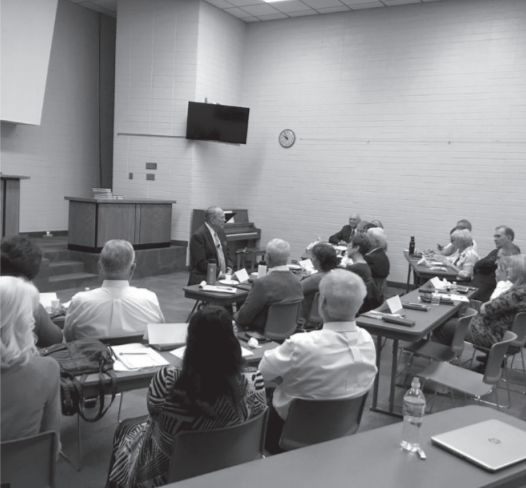 CES senior missionary couple training at the MTC in Provo, Utah, in 2017. Courtesy of Po Nien (Felipe) Chou.
CES senior missionary couple training at the MTC in Provo, Utah, in 2017. Courtesy of Po Nien (Felipe) Chou.
President Thomas S. Monson reminded Latter-day Saints that “we continue to need many more senior couples. As your circumstances allow, as you are eligible for retirement, and as your health permits, I encourage you to make yourselves available for full-time missionary service. Both husband and wife will have a greater joy as they together serve our Father’s children.”[24] The Lord is aware of the sacrifice and faith of senior missionaries who leave their families and their homes. President Gordon B. Hinckley said, “The sacrifices associated with serving the Lord full time will abundantly bless couples, their families, and the people they serve.”[25]
Although some senior missionary couples were overwhelmed and anxious about their calling and assignment, they generally valued and appreciated the training they received at the MTC. They expressed feelings like “The training was extremely valuable. . . . They [the instructors] taught and helped us learn valuable teaching skills,” “The material taught and modeled was very useful,” and “I enjoyed and was surprised to learn new ways to teach the doctrine . . . [and] appreciated how organized the lessons were.”[26] Following their experience at the Missionary Training Center, they went forth with faith to their assigned field of labor.
CES Assignments and Experiences around the World
Senior missionary couples may experience a wide variety of CES assignments inside and outside the United States. About 38 percent of senior missionary couples are called to serve within the US compared to 62 percent sent outside the US.[27] The various CES missionary assignments in 2018 included CES coordinators, stake young single adult program (SYSAP), international teacher education program (ITEP), or technical and vocational education and training (TVET), or others (for example, BYU–Hawaii, BYU–Idaho, Pathway, education specialists, and so forth).[28]
According to a sister missionary who works with the CES senior missionary coordinators at the Church Office Building, “the majority of our [senior missionary] couples are called to teach seminary and institute. . . . But there are other couples (ITEP, TVET, and BYU–H) who are not teaching seminary and institute, but who are teaching within the Church Education System.”[29] The pre-field services group manager for the Missionary Department said that “senior missionaries are especially needed because they can serve in areas where younger missionaries can’t.”[30] Although most of these senior missionary couples will teach institute, each assignment is unique and is adapted to the needs of the area and the missionary couple.
CES missionary/
As noted, there are many possible CES missionary assignments for a senior missionary couple. Of these assignments, most or nearly half are assigned as S&I missionaries or coordinators. In 2018, for example, S&I missionaries or coordinators accounted for 141 out of 306 CES missionary couples, or 46 percent of all CES senior missionary couples serving.[31] They serve in many locations inside and outside the US teaching seminary, institute, or both and supporting and training stake-called seminary or institute teachers. They coordinate with local priesthood leaders and help to oversee the seminary and institute programs under their area of stewardship.
A former missionary couple in the Philippines who helped coordinate seminary and teach institute said, “[We] met wonderful local saints and developed eternal friendships and relationships.” They encouraged others to serve missions, enjoy wherever they serve, and love the people and the culture. They recounted hearing Elder Kent Watson, then Asia Area President and member of the Quorum of the Seventy, say in 2010, “As the Church has grown in Asia, I have come to love and appreciate a group of people who seek no reward, no honor, or other worldly things. They seek only to glorify our Father in Heaven. They are our senior missionaries, wonderful, seasoned brothers and sisters who are quietly and diligently helping to ‘lay the foundation of this Church.’”[32]
While serving in Virginia, one missionary couple helped teach and coordinate institute classes at Southern Virginia University (SVU), the Virginia Military Institute (VMI), and in the surrounding areas. They had all kinds of activities for the college students and young single adults, including quilting, lunches, family home evenings, games, temple excursions, visits to historical sites, and so forth. While in Virginia, they came to love the young single adults, as well as other senior couples they served with.[33] The labor of these senior missionaries helped to further the work of salvation and to bring souls unto Christ.
Another missionary couple had received a call to serve their mission in Japan, so they were surprised to learn that their assignment had changed to Taiwan. When they arrived in Taiwan in 2001, they were greeted at the airport by the mission president and coordinator who would help to get them settled in their new apartment and orient them to their new assignment. They wondered how they would teach institute and help train new stake-called seminary and institute teachers from the various wards and branches without knowing the language. As they moved forward with faith (along with some anxiety, fear, and trepidation), they found out that the Lord had anticipated and prepared a way to help them fulfill their mission call. Their local stake president and other returned missionaries spoke English. Arrangements were made for them to teach institute classes with the help of local translators. The institute students especially enjoyed single adult dances, where this missionary couple taught them a variety of dances, including ballroom, swing, and country. They had not realized that they were the first CES senior missionary couple to serve in Taiwan, but they learned that their love for the students and their example of a gospel-centered marriage were more important than their ability to speak the language. When they concluded their mission, seminary and institute enrollment had increased, and a full-time coordinator replaced them to continue the program.[34]
A former assistant administrator over Asia explained the important function that these missionaries or coordinators serve as they assist the seminary and institute programs in various parts of the world, especially where the Church may be relatively new. In many developing countries, or areas in Africa or Asia, for example, these missionaries or coordinators are often the first to introduce and teach seminary and institute classes, which are critical both to supporting weekday religious education and to strengthening the faith and testimony of new converts. In many of these countries where the Church may be relatively small, the Church sends a senior missionary couple to establish seminary and institute programs until there are enough seminary and institute students enrolled to justify hiring a part- or full-time coordinator or employee. A former S&I assistant administrator said, “We hope that after two or three missionary couples, the seminary and institute enrollment would have grown and our [seminary and institute] programs would have matured enough to allow S&I to hire a part-time or full-time coordinator.” He added, “Wherever the Church and missionaries goes, CES or S&I follows closely behind.”[35]
Stake Young Single Adult Program (SYSAP)
The second most common CES senior missionary assignment is to serve as stake young single adult program (SYSAP) missionaries, serving at a center for young adults (CFYA). These gathering places were initially started in Europe and Africa and later added in parts of the USA. They were part of the collaborated efforts of the Priesthood Department, the Missionary Department, and the Department of Seminaries and Institutes of Religion.[36] In 2018, there were eighty-eight senior missionary couples serving with stake single adult programs, accounting for about 29 percent of CES senior missionaries.[37]
According to the 2011 Center for Young Adults—Supplemental Instructions and Guidelines published by the Church, the purpose of these sites (typically a shared-use Church meetinghouse or an institute building) is to provide “a place where young single adults can safely gather under priesthood direction for activation efforts, gospel learning, missionary work, help with education and employment goals, and social and service activities.” Senior missionary couples serving in stake young single adult programs assist by “(1) helping maintain the center’s operations and spiritual environment, (2) assisting leaders who are responsible for the center, (3) assisting with missionary work, and (4) teaching institute of religion classes.”[38] These gathering places provide a place of refuge for young single adults to gather and socialize with their peers, participate in wholesome activities and develop friendships, and to strengthen their testimonies.[39]
A past senior missionary couple began their service in the Accra Ghana Mission in 2016 before transferring back to the US to complete their mission because of health issues. They were first assigned to teach institute and work with the stake young single adult program in Ghana and then they were asked to assist with membership records before helping as maintenance missionaries.[40] Although their mission was difficult and discouraging at times, they were blessed to help a young adult in Ghana enter the waters of baptism during their service with the stake young single adult program.
After arriving [in Ghana], . . . there really wasn’t a spot for us [and] it was a little hard and discouraging. . . . We just tried to fit in somewhere. . . .
It was pretty discouraging for my husband until he met Frances . . . [at the mall, who] offered assistance in helping my husband find a rug. . . . Frances talked with my husband about how the world needed more goodness and love, etc. Therin [my husband] offered to have missionaries come to teach him. . . .
Therin would expound on what the missionaries taught him and give him more scriptures that they would read together on the phone (we lived two hours away). In March, Frances called and asked Therin to baptize him. . . . He baptized Frances on Palm Sunday 2016 and confirmed him the next week on Easter Sunday. That was the highlight of our mission. A week before we returned home, we were able to take him to the temple and Therin was able to baptize him for the dead. It was a very spiritual experience. Frances . . . is preparing to receive his endowments currently and teaches family history. He has been sharing the gospel with others and helping in their baptisms. . . .
We did have some great experiences while we were [in Ghana]. . . . Francis calls us mom and dad and we stay in contact often. . . .
We had some good experiences even though it wasn’t what we had [expected]. . . . We knew we were supposed to go [to Ghana] for [Frances’s] baptism.[41]
In July 2012, the First Presidency issued a letter regarding the CFYA, noting that the “use of the name ‘center for young adults’ has been discontinued, . . . [and] ‘stake young single adult program’ should be used instead.” It also instructed that existing “Church buildings such as chapels and institute facilities are to be used as gathering places for young single adult programs, activities, and institute classes.” SYSAP senior missionary couples continue to serve young single adults today following this updated instruction.
International Teacher Education Program (ITEP) and Technical and Vocational Education and Training (TVET)
Several CES senior missionary couples are also called and assigned to support the Church’s elementary and secondary schools across the various nations and kingdoms in the islands of the Pacific. These schools in the Pacific include Fiji, Kiribati, Samoa, and Tonga. They are International Teacher Education Program (ITEP) and Technical and Vocational Education and Training (TVET) missionary couples, who help support teacher education for the various Church schools and technical and vocational training for many students at these schools. In 2018 there were ten CES senior missionary couples, or about 3 percent of all CES missionary couples serving as ITEP/
A missionary couple who served with the International Teacher Education Program from 1999 to 2000 trained teachers at Moroni High School, a Church school in Kiribati. They recalled a meeting at BYU–Hawaii with their coordinators to discuss possible courses before they arrived at Kiribati. These coordinators had visited Kiribati and had left some sample syllabi, as well as course textbooks used at BYU–Hawaii. However, when the new missionary couple arrived in Kiribati, “the course syllabi and textbooks could not be found, . . . [so they] started the class with 24 teachers and administrators flying by the seat of [their] pants.” They said it took almost seven weeks before the materials finally arrived, but going without them at first provided them with a faith-promoting experience, as she recounted below:
While we were still home preparing to leave and purchasing items, . . . Roy had indicated that he would really like to find the video The King and I to take to Kiribati. I asked him why he thought he needed it, and he answered, “I don’t know—I just feel it would be a good idea to have it. I’ve always liked the words to the song ‘Getting to Know You.’” . . . Then, one day when Roy was doing some shopping on his own, he found the video! . . . When we arrived in Kiribati, we discovered the much-needed textbooks that were supposed to be in our apartment weren’t there, and we were under pressure to start teaching our first class within a few weeks. During those initial weeks, Roy was truly blessed through the insights and inspiration he received in preparing for the pedagogy class without the aid of a textbook. . . . He used the highly sought-after video The King and I as an extremely effective and valuable part of his introduction. As quickly as he prepared lesson plans, I typed and prepared the handouts and other resource materials; . . . the much-needed textbook arrived nearly seven weeks after our arrival in Kiribati. We were absolutely astounded and humbled to the point of tears as we opened the recently arrived textbook to the table of contents only to find that it matched almost identically the lessons and presentations Roy had prepared and taught. Not only that, but the introduction included the words to the song “Getting to Know You” from The King and I! This was an incredibly humbling and spiritual experience! It confirmed to us even more that we were where the Lord wanted us to be.[43]
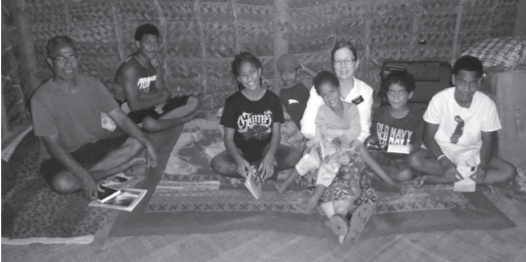 Sister Bearce with a family in their fale, who benefited by the solar electricity project by the students at Liahona High School in Tonga in 2016. Courtesy of Elder and Sister Bearce.
Sister Bearce with a family in their fale, who benefited by the solar electricity project by the students at Liahona High School in Tonga in 2016. Courtesy of Elder and Sister Bearce.
In another part of the Pacific, another missionary couple served as Technical and Vocational Education and Training missionaries in the Tonga Nuku’alofa Mission from 2015 to 2017. They were assigned to Liahona High School, a Church school on the main island in the Kingdom of Tonga. Their area supervisor in New Zealand assigned them the following responsibilities during their mission: strengthen teaching methods and practices, help teachers and departments develop inventories and curriculum-based plans, forge or strengthen relationships with certifying tertiary educational institutions, encourage and incorporate certification study and testing into their curriculum, help teachers apply classroom skills to real-world projects, and encourage support of vocational classes and projects.[44]
One mission experience from this missionary couple illustrates how their service helped students develop vocational skills while blessing a family in their community. While on their mission, someone asked them “if the Liahona High School vocational electricity class could help a poor family living in a fale [a traditional Tongan hut] to install electric lights so that the six children could study school lessons and read scriptures after sunset.” They explained that the power company could not run power to a hut due to the fire hazard. Accompanied by another missionary and the school electricity teacher, they used donated funds to buy a small solar power system and four LED bulbs. Their students were trained about solar energy and installation procedures, and together they installed the system for that family. They recalled going to visit the family one evening “to deliver children’s books and read with the children under their new lights.” They found that “several of the children are now honor students at their local schools and the entire family is prospering.” In addition, the seventeen students in the electricity class were humbled by the opportunity to participate in the project and to see its effect on the lives of a family in their community.[45] These missionary couples are doing more than just teaching reading or technical skills, they are blessing the lives of those they serve.
Other Senior Missionary Assignments
Senior missionary couples have also received a variety of other CES assignments based on the needs of the program at the time. For example, some serve as Perpetual Education Fund (PEF) senior missionary couples while others continue to teach at BYU–Hawaii or serve as Education Specialist missionaries. Most recently, some have been called to serve with the Pathway program or BYU–Pathway Worldwide. Although these senior missionary couples are a smaller group compared to coordinators or missionaries serving with stake young single adult programs, their service is critical and a blessing to those they serve throughout the world.
A representative from BYU–Pathway Worldwide explained to senior missionary couples during their training in the Provo MTC that there are many members throughout the world who lack time, money, confidence, and resources to advance their education and economic situation. When the Pathway pilot program was launched in 2009, it included three sites with fifty students and has since grown to include thousands of students in multiple sites and countries. It was designed as a one-year course that included online modules and local meetings, with a simple application process and minimal cost to members of the Church. After an individual successfully completes the Pathway program, he or she may choose to take BYU–Idaho online courses and earn a certificate, associate’s degree, or bachelor’s degree. Missionary couples called to help with the Pathway program assist individuals with educational opportunities and provide them with hope for a better and brighter future.[46]
A missionary couple that served as education specialist missionaries in French Polynesian Tahiti from 2015 to 2016 explained that they helped the mission president, assisted with educational needs, and helped to start the Church’s Pathway program in Tahiti. The husband was also the fleet manager while his wife organized and directed mission choirs, cared for sick missionaries, and helped with zone conferences and missionary transportation. However, their primary assignment and greatest challenge was helping the Tahitian people understand the value of education, as they explained with the following:
The greatest challenge was the culture of the Tahitian people, which was not a culture of higher education. In fact, it was just the opposite: almost half of the Tahitian teens dropped out of high school at age 16 because they could legally do so, and of those that graduated, there were few that went on to university because the economy was so bad that there were not many opportunities for jobs, even with an education.
We eventually developed a program of meeting with the youth and their parents in a ward meeting where we talked to the parents first about the blessings of education for their children (without offending them about their lack of education), then tried to inspire the youth to have a vision for their future that included education. We even had the opportunity of meeting with wards from other islands. Whole families would come to spend a week going to the temple and we arranged to meet with the groups for our presentation on education.[47]
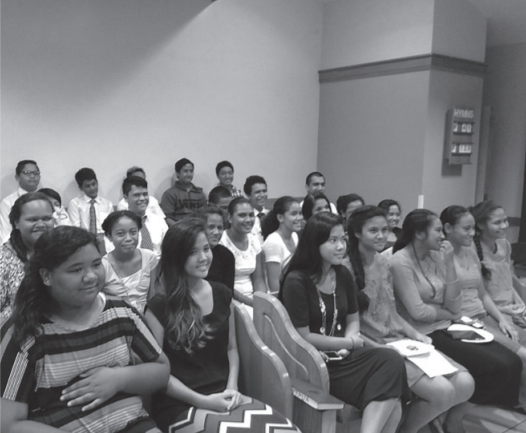 Youth from Fatutaua and Papeete at an education meeting taught by Elder and Sister Caldwell in 2016. Courtesy of Elder and Sister Caldwell.
Youth from Fatutaua and Papeete at an education meeting taught by Elder and Sister Caldwell in 2016. Courtesy of Elder and Sister Caldwell.
They started one Pathway class in Tahiti, which expanded to three classes across the island during their mission. These Pathway classes were an onboarding or induction program to help individuals increase their English language skills to prepare them to attend online college courses provided by BYU–Idaho. This missionary couple shared their experience as follows:
Pathway was such a joy to be a part of!
Our students included bishops and members of stake presidencies improving their English and strengthening their job skills; a woman trying to start her own business and her returned missionary granddaughter who was applying to BYU–Hawaii; a husband and wife beginning their own after-school program for children; a woman who wanted to improve her English to be able to study the many LDS doctrinal books not available in French; many men and women who had dropped out of high school and now knew the value of education, including one man who gained the learning skills and the self-confidence to go on to the university and become a math teacher; and many young people who understood that an education would improve the quality of their lives, like Ness, whom we met during one of the ward temple trips and who then moved from his home island to come to Tahiti so that he could attend Pathway.
Didier was a man in his thirties who had a career but knew that education could improve his life. He was a dedicated student and helped the others in his class who struggled a little. He completed Pathway, was accepted to BYU–Idaho, and when we left, was on his way to getting his degree in computer systems.
But perhaps the most tender experience for me was the sister who, after attending almost a year of Pathway, had the courage to watch the English broadcast of General Conference. “Oh, Sister Caldwell,” she said, with tears in her eyes, “that is the first time I ever hear the actual voice of the prophet, not the voice of the interpreter. I feel the Spirit so strong as I listen to the prophet in his own voice!”
We saw the blessings of education and the gospel change lives in Tahiti, but maybe the greatest blessings were those that came to us as we served in this great work.[48]
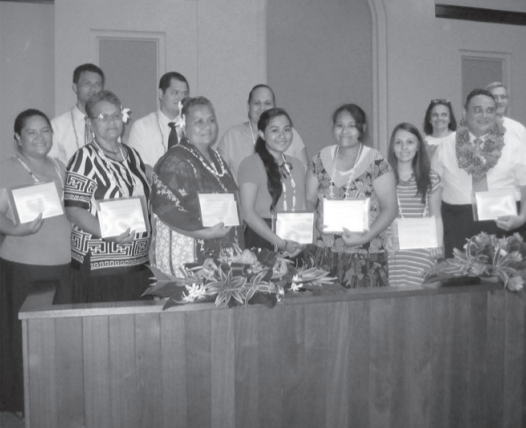 Pathway graduates in French Polynesian Tahiti in 2016. Courtesy of Elder and Sister Caldwell
Pathway graduates in French Polynesian Tahiti in 2016. Courtesy of Elder and Sister Caldwell
Conclusion
Elder Robert D. Hales said, “We wish to express our appreciation for all those valiant couples who are currently serving, those who have served, and those who will yet serve.” He gave the following promise to these missionary couples, “If we are willing to leave our loved ones for service in the mission field, we will bless them with a heritage that will teach and inspire them for generations to come,” and “As we serve in the mission field, our children and grandchildren will be blessed in ways that would not have been possible had we stayed at home. . . : inactive children activated, family members baptized, and testimonies strengthened because of their service.”[49]
Members of the Church throughout the world are blessed by the service of CES senior missionary couples. Although these senior missionary couples may be anxious and concerned about their families back home or the limited knowledge or uncertainty of their upcoming mission call and assignment, they display a tremendous amount of faith to answer the call to serve wherever they are needed. Regardless of their assignments, these senior missionary couples bring with them a wealth of knowledge and understanding of Church government and programs. More importantly, they are an example of faithful Latter-day Saints who have a deep conviction and testimony of the restored gospel. Their selfless sacrifice is an inspiration and blessing to those left back home as well as those they will interact within the mission field. They are a blessing to those they serve and play an important role in strengthening the youth and young adults of the Church throughout the world.
President Russell M. Nelson, then a member of the Quorum of the Twelve, taught that “along with [young missionaries] are marvelous senior missionaries who have answered the pleadings of prophets and apostles for more missionary couples.” He then said, “I express gratitude for our senior missionaries. They are young in spirit, wise, and willing to work. They even tolerate remarks from their fun-filled children who might change President Spencer W. Kimball’s plea ‘Lengthen your stride’ to ‘Hasten your shuffle.’ These dear members are willing to serve and strengthen the lives of others. Even if these seniors don’t know the local language, their accomplishments are great and their spirit of sacrifice is precious.”[50]
Notes
[1] R. Lanier Britsch, From the East: The History of Latter-day Saints in Asia, 1851–1996 (Salt Lake City: Deseret Book, 1998), 308–11; By Study and Also by Faith: One Hundred Years of Seminaries and Institutes of Religion (Salt Lake City: The Church of Jesus Christ of Latter-day Saints, 2015), 415.
[2] “News of the Church: Missionaries in Mongolia,” Ensign, November 1992.
[3] “News of the Church: Missionaries in Mongolia.”
[4] S&I and all Church schools fall under the umbrella of CES. However, CES and S&I have been and are sometimes used interchangeably.
[5] Po Nien (Felipe) Chou and Petra Mei Wah Sin Chou, Voice of the Saints in Taiwan (Provo, UT: Religious Studies Center, Brigham Young University; Salt Lake City: Deseret Book, 2017), 333–34.
[6] Kam Tim Kwok, interview by Po Nien (Felipe) Chou and Petra Chou, October 2016, Hong Kong, China.
[7] Khumbulani Mdletshe, email message to author, September 2016.
[8] Kendall and Anna Ayers, interview by Po Nien (Felipe) Chou, 20 September 2017, Provo, Utah.
[9] Ayers and Ayers, interview.
[10] Ayers and Ayers, interview.
[11] Sarah Harris, “Senior Missionaries Are ‘Needed, Blessed, Loved,’” Church News, 1 September 2017.
[12] Ayers and Ayers, interview.
[13] David A. Bednar, “Called to the Work,” Ensign, May 2017, 67–68.
[14] Ronald A. Rasband, “The Divine Call of a Missionary,” Ensign, May 2010, 52.
[15] Rasband, “Divine Call of a Missionary,” 52–53
[16] Ayers and Ayers, interview.
[17] Ayers and Ayers, interview.
[18] “CES Missionary Training: MTC Experience,” a report by the S&I Office of Research, 28 October 2011, Salt Lake City, Utah.
[19] “CES Missionary Training: MTC Experience.”
[20] Doug Hart, “Senior Missionary Training—MTC Experience,” memo from S&I Administrators’ Council to all Area Directors, 21 February 2011.
[21] Clint Udy, “Senior Missionary Training presentation,” 18 September 2017, Provo, Utah.
[22] Ayers and Ayers, interview.
[23] Ayers and Ayers, interview.
[24] Thomas S. Monson, “Welcome to Conference,” Ensign, November 2012, 5.
[25] Gordon B. Hinckley, “To the Bishops of the Church” (Worldwide Leadership Training Meeting, 19 June 2004), 27; see also “Excerpts from Recent Addresses of President Gordon B. Hinckley,” Ensign, April 1996, 72.
[26] “CES Missionary Training: MTC Experience.”
[27] “CES Missionary Training: MTC Experience.”
[28] Kathryn Williams, email message to author, 28 February 2018.
[29] Williams, email.
[30] Harris, “Senior Missionaries Are ‘Needed, Blessed, Loved.’”
[31] Williams, email.
[32] Ayers and Ayers, interview.
[33] Ayers and Ayers, interview.
[34] Po Nien (Felipe) Chou, personal history and journal entries, 2000–2002; Chou and Chou, Voice of the Saints in Taiwan, 333–34.
[35] Ross Cole to Po Nien (Felipe) Chou, personal discussion notes, Taipei, Taiwan, 2001; Chou, personal history and journal entries, 2000–2002.
[36] The Church of Jesus Christ of Latter-day Saints, Centers for Young Adults—Supplemental Instructions and Guidelines, 2011.
[37] Williams, email.
[38] Centers for Young Adults.
[39] Richard Hawks to Po Nien (Felipe) Chou, personal discussion notes, Salt Lake City, Utah, 2012; Chou, personal history and journal entries, 2012.
[40] Therin and Roelene Taylor, email message to authors, 26 March 2018.
[41] Taylor and Taylor, email.
[42] Williams, email.
[43] Roy and Pat Ottley, email message to authors, 3 January 2018; Roy and Pat Ottley, “Among the miracles of our mission to Kiribati,” personal history, 2000.
[44] Charles and Jerri Bearce, email message to authors, 8 March 2018.
[45] Bearce and Bearce, email.
[46] April Spalding, “BYU Pathway World presentation,” 20 September 2017, Provo, Utah.
[47] Edward and Christine Caldwell, email message to authors, 13 March 2018.
[48] Caldwell and Caldwell, email.
[49] Robert D. Hales, “Couple Missionaries: A Time to Serve,” Ensign, May 2001, 25.
[50] Russell M. Nelson, “Senior Missionaries and the Gospel,” Ensign, November 2004, 79.
